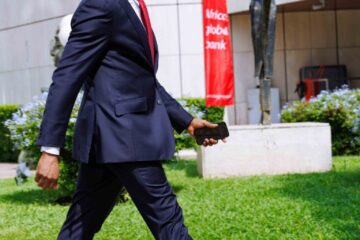NBC’s MPI index: How SME’s moved Abia into top rich state (Opinion)

Gov Ikpeazu of Abiaa State
When the National Bureau of Statistics (NBS), released a Multidimensional Poverty Index (MPI) survey report that measured deprivations related to education, health, and living standard of the people and Abia was among the top states, many did not pay attention to what happened.
Nobody in Abia State can comfortably say that Dr Okezie Ikpeazu as a Governor has done it all but the NBS publication has shown that after all, Ikpeazu’s promise of delivering a better life for the people of the state is a clear reality.
Abia is a state where people are well known for their industrious lifestyle and hard-working nature. It did not start under Okezie Ikpeazu but the coming of Ikpeazu became a catalyst for rapid growth and development of all those involved in Small and Medium Enterprises (SMEs) in Aba.
One concrete influence Ikpeazu had on SMEs in Abia State is his becoming their Chief Marketer, changing the narrative about made in Aba products. The Governor completely rewrote the age-long story of Aba shoemakers, and other designers and made them proud to say their products were made in Aba.
He vowed to wear only made-in-Aba products throughout his stay in office. Not only did he do that but he also took their products to important government agencies like the army, police, National Youth Service Corps (NYSC) and the Nigerian Railway Cooperation, thereby creating serious and available markets for them.
When he noticed the lack of modern equipment available to Aba shoemakers which will not allow them to compete favourably with the rest of shoemakers over the world, he set up the Enyimba Automated Shoe Company (ENASCO) where individual shoemakers can bring their designs and have them produced by advanced machines.
The government equally went ahead to launch an online business directory for small and medium businesses in the state, a measure that currently boast E-commerce in the state making it possible for customers all over the world to buy products in Aba.
Ikpeazu exposed SMEs in the state to the world because the Abia SME directory contains business names, addresses, telephone numbers, locations, contact information, the type of service or products the business provides, and the number of employees among other things.
Ikpeazu restored the Abia SME and equally became a pacesetter in human capital development in Aba, the commercial hub of the state, a situation that has given youths impetus to go ahead with production.
Abia under Ikpeazu became the first state to have the Ministry of Small and Medium Enterprises Development that serves as a clearing house for all SME-related activities. The ministry forms the catalyst for business development, marketing and empowerment. Abia is also the first to establish an SME bank tailored towards helping small businesses thrive. These achievements are among the reasons why the rating of Abia has improved in many ways.
The Abia SME bank on its own is Microfinance Bank meant to meet the needs of Abia Small and Medium-sized Enterprises owners that are currently not being met by numerous commercial banks.
The bank is specifically providing micro-credit to SMEs to enhance economic growth in line with the Ikpeazu-led administration macroeconomic policy of empowerment and wealth creation for Abia people and others doing business in Abia State.
What makes the Abia SME Microfinance Bank located at No 17 Ngwa Road, Aba very unique is that despite providing micro-credit to Abia State SMEs, it equally offers efficient and innovative financial services and products to the economically viable SMEs segment.
Today, many areas of businesses in Aba in particular are having specialized clusters where their businesses are meant to thrive without restrictions, as the government equally says it will construct more roads with economic importance to ease trade and commerce in the state.
Perhaps, the efforts of the current administration in Abia State in SMEs will be appreciated more when one visits the Cameroun Park through the Powerline axis of Ariaria International Market to see how people from Central and West African cities like Bangui, Libreville, Bamako, Malabo, N’Djamena, Bioko and Kumba come to buy made in Aba goods for their numerous customers back at home in their countries.
Undoubtedly a rich nation by every standard, one third of over 200
million population size of Nigeria citizens are terminally poor confronted with existential challenges.
To ameliorate the poverty level, the Federal Government introduced a
poverty reduction template which targets lifting 100 million Nigerians from poverty belt zone by 2030.
This is a task the government says is attainable, if stakeholders play their expected roles effectively.
Regrettably, poverty is ballooning in Nigeria rather than receding. A poverty report released last week by the National Bureau of Statistics (NBS)- Multidimensional Poverty Index (MPI) survey is the latest in poverty indices measuring Nigeria’s ranking in the poverty ladder.
According to the NBS’ MPI, 63 per cent of persons living within Nigeria ( about 133 million people) are multidimensionally poor.
Put in proper context, the report which has elicited wide reviews, showed that poor people in Nigeria experience over one-quarter of all possible deprivations.
Poverty levels vary significantly across and by extension regions. When it comes to states, incidence of multidimensional poverty is low in Ondo State with 27 per cent and highest in Sokoto with 91 per cent.
The report said over half of the population of Nigeria are multidimensionally poor and cook with dung, wood or charcoal, rather than cleaner energy. High deprivations are also apparent nationally in sanitation, time to healthcare, food insecurity, and housing.
The MPI report was collaboratively conducted by the NBS, the National Social Safety-Nets Coordinating Office (NASSCO), the United Nations Development Programme (UNDP), the United Nations Children’s Fund
(UNICEF), and the Oxford Poverty and Human Development Initiative (OPHI).
When aggregated by zone, the MPI showed 65 per cent of poor people—86 million—live in the North, while 35 per cent—nearly 47 million—live in the South. The report indicated that nutritional deprivations are highest in the North West, but food insecurity is relatively more frequent across the South.
Poverty breakdown in relation to regions are as follows: North West, 45.5 million, North East, 20.5 million; South West, 16.3 million; North Central, 20.2 million, South South 19.7 million and South East 10.5
million.
Unemployment, according to the report contributes more to MPI in South South than in other zones, whereas security shocks contribute more in South South, North Central and North East.











